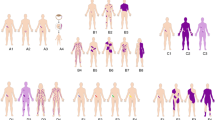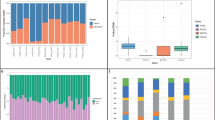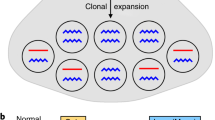Abstract
Children with the Beckwith-Wiedemann syndrome have a greatly increased potential for the specific development of the embryonal tumours hepatoblastoma, rhabdomyosarcoma and Wilms' tumour. Data obtained with molecular probes suggest that the association between these disparate, rare tumour types reflects a common pathogenetic mechanism that entails the somatic development of homozygosity for a mutant allele at a locus on human chromosome 11.
This is a preview of subscription content, access via your institution
Access options
Subscribe to this journal
Receive 51 print issues and online access
$199.00 per year
only $3.90 per issue
Buy this article
- Purchase on Springer Link
- Instant access to full article PDF
Prices may be subject to local taxes which are calculated during checkout
Similar content being viewed by others
References
Willis, R. A. Pathology of Tumours 4th edn 7–8 (Butterworth, London, 1967).
Nicholson, G. W. J path. Bact. 34, 711–730 (1931).
Warkany, J. Congenital Malformations 1199–1271 (Year Book, Chicago, 1971).
Best, L. G. & Hoekstra, R. E. Am. J. med. Genet. 9, 291–299 (1981).
Sotelo-Avila, C. & Gooch, W. M. Perspect. Pediat. Path. 3, 255–272 (1976).
Sotelo-Avila, C., Gonzalez-Cmssi, F. & Fowler, J. W. J. Pediat. 96, 47–50 (1980).
Muller, S., Gadner, H., Weber, B., Vogel, M. & Riehm, H. Eur. J. Pediat. 127, 219–226 (1978).
Riedel, H. A. Pediatrics 10, 19–27 (1952).
Miller, R. W., Fraumeni, J. F. & Manning, M. D. New Engl. J. Med. 270, 922–927 (1964).
Tefft, M., Vawter, G. F. & Mitus, A. Am. J. Roentg. 103, 800–822 (1968).
Milmun, D. H. & Grayzel, D. M. Am. J. Dis. Child. 81, 408–420 (1951).
Schweisgoth, O. Solid Tumors in Children (Wiley, New York, 1982).
Potter, E. L. Normal and Abnormal Development of the Kidney, 263 (Year Book, Chicago, 1972).
Wigger, H. J. Hum. Path. 7, 613–623 (1976).
Sheehan, H. L. J. path. Bact. 33, 251–258 (1930).
Wilkins, L. & Ravitch, M. M. Pediatrics 9, 671–681 (1952).
Pack, G. T. & Miller, T. R. AMA Archs Surg. 73, 1060–1062 (1956).
Koufos, A. et al. Nature 309, 170–172 (1984).
Orkin, S. H., Goldman, D. S. & Sallan, S. E. Nature 309, 172–174 (1984).
Reeve, A. E. et al. Nature 309, 174–176 (1984).
Fearon, E. R., Vogelstein, B. & Feinberg, A. P. Nature 309, 176–178 (1984).
Cavenee, W. K. et al. Nature 305, 779–784 (1983).
Cavenee, W. K. et al. Science 228, 501–503 (1985).
Barker, D., Schafer, M. & White, R. Cell 36, 131–138 (1984).
Dracopoli, N. C. & Fogh, J. J natn. Cancer Inst. 70, 83–87 (1983).
Cavenee, W., Leach, R., Mohandas, T., Pearson, P. & White, R. Am. J. hum. Genet. 36, 10–24 (1984).
Wyman, A. R. & White, R. Proc. natn. Acad. Sci. U.S.A. 77, 6754–6758 (1980).
Skolnick, M. H., Willard, H. F. & Menlove, L. A. Cytogenet. Cell. Genet. 37, 210–273 (1984).
Riccardi, V. M., Sujansky, E., Smith, A. C. & Francke, U. Pediatrics 61, 604–610 (1978).
Turleau, C. et al. Hum. Genet. 67, 219–221 (1984).
White, R. et al. Nature 313, 101–105 (1985).
Gusella, J. F. et al. Science 225, 1320–1326 (1984).
Barker, D., Holm, T. & White, R. Am. J. hum. Genet. 36, 1159–1171 (1984).
Gerald, P. S. & Grzeschik, K. H. Cytogenet. Cell. Genet. 37, 103–126 (1984).
Bell, G. I., Selby, M. J. & Rutter, W. J. Nature 295, 31–35 (1982).
Goldfarb, M., Shimizu, K., Perucho, M. & Wigler, M. Nature 296, 404–409 (1982).
Antonarakis, S. E., Boehm, C. D., Giardina, P. J. & Kazazian, H. H. Proc. natn. Acad. Sci. U.S.A. 79, 137–141 (1982).
Author information
Authors and Affiliations
Rights and permissions
About this article
Cite this article
Koufos, A., Hansen, M., Copeland, N. et al. Loss of heterozygosity in three embryonal tumours suggests a common pathogenetic mechanism. Nature 316, 330–334 (1985). https://doi.org/10.1038/316330a0
Received:
Accepted:
Issue Date:
DOI: https://doi.org/10.1038/316330a0
This article is cited by
-
Molecular characteristics and therapeutic vulnerabilities across paediatric solid tumours
Nature Reviews Cancer (2019)
-
Investigating loss of heterozygosity in a SCRaMbLEd yeast genome
Science China Life Sciences (2019)
-
Synthetic genome with recoding
Science China Life Sciences (2019)
-
Association of trisomy 18 with hepatoblastoma and its implications
European Journal of Pediatrics (2014)
Comments
By submitting a comment you agree to abide by our Terms and Community Guidelines. If you find something abusive or that does not comply with our terms or guidelines please flag it as inappropriate.



